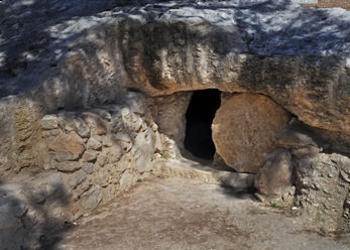Did Jesus Fulfill His Prophecy of How Long He Would Be Entombed?

In Matthew 12:38, some of the scribes and Pharisees asked Jesus for a sign to prove He was the Messiah. "Teacher, we want to see a miraculous sign from you," they told Him (New International Version).
Jesus responded that the only sign He would give was that of the prophet Jonah: "For as Jonah was three days and three nights in the belly of a huge fish, so the Son of Man will be three days and three nights in the heart of the earth" (Matthew 12:40, NIV).
But how can we fit "three days and three nights" between a Friday afternoon crucifixion and entombment just before sundown and a Sunday morning resurrection at sunrise? This traditional view allows for Jesus to have been in the tomb for only a day and a half—or half the time Jesus foretold!
Traditional view doesn't fit
Some believe that Christ's statement that He would be "three days and three nights in the heart of the earth" does not require a literal span of 72 hours. They reason that any part of a day can be reckoned as a whole day.
Thus, since Jesus died in the afternoon and was entombed just before sunset, they think the closing few minutes of that Friday constituted the first day, Friday night was the first night, Saturday was the second day, Saturday night was the second night, and a few minutes at dawn on Sunday morning made up the third day.
But where, then, is the third night? Even if a few minutes of daylight late on Friday and another few on Sunday morning constitute "days," this interpretation fails to explain how only two nights—Friday night and Saturday night—can somehow be the three nights of which Jesus spoke.
In fact, Scripture is plain that Jesus had already risen before Mary Magdalene came to the tomb early Sunday morning, arriving "while it was still dark" (John 20:1-2). So in reality, no parts of Sunday could be counted as a day, as Jesus was already resurrected well before the break of dawn.
Jonah 1:17, to which Jesus referred, states specifically that "Jonah was in the belly of the fish three days and three nights." We have no biblical basis for thinking that Jesus meant only two nights and one day, plus part of another day.
If Jesus were in the tomb only from late Friday afternoon to early Sunday morning, then the sign He gave that He was the prophesied Messiah was not fulfilled.
So which is it? Is something wrong with Christ's words, or is something wrong with the traditional view of when and how long He was in the tomb?
Let's carefully examine the details from the Gospels. When we do, we uncover the real story of how Jesus' words were fulfilled precisely.
Two Sabbaths mentioned
Notice the sequence of events outlined in Luke 23. Jesus' moment of death, as well as His hasty burial because of the oncoming Sabbath that began at sundown, is narrated in Luke 23:46-53. Luke 23:54 then states, "That day was the Preparation, and the Sabbath drew near."
In Jewish society of that time, heavy cooking and housecleaning were done on the day before a Sabbath in preparation for it. Thus the day before the Sabbath came to be called "the preparation day" or simply "the preparation." The biblical Sabbath falls on Saturday, the seventh day of the week. According to Bible reckoning, days begin at sunset (Leviticus 23:32; compare Genesis 1:5, Genesis 1:8, Genesis 1:13), so all weekly Sabbaths start Friday evening at sundown.
Based on these facts, many people have assumed that it is the weekly Sabbath mentioned here, and that Jesus was therefore crucified on a Friday. But two types of "Sabbaths" are mentioned in the Scriptures—the regular weekly Sabbath day, which fell on the seventh day of the week, and seven annual Holy Days (listed in Leviticus 23), Sabbaths that could—and usually did—fall on days of the week other than the regular weekly Sabbath day.
Was the day after Jesus was crucified a weekly Sabbath, or one of these annual Holy Days?
John 19:31 clearly states that this approaching Sabbath "was a high day." This term does not refer to the weekly Sabbath (Friday sunset to Saturday sunset), but in this context to the first day of Unleavened Bread, one of God's annual Holy Days (Exodus 12:16-17; Leviticus 23:6-7). A number of Bible commentaries, encyclopedias and dictionaries will confirm that John is not referring to the weekly Sabbath here, but rather to one of the annual Sabbaths.
According to the biblical evidence, in that year this high-day Sabbath fell on a Thursday (meaning it began on Wednesday night at sunset). This becomes especially clear from details in the Gospel accounts showing us that two separate Sabbath days are mentioned.
Luke 23:55-56 tells us that the women, after seeing Christ's body being laid in the tomb just before sundown, "returned and prepared spices and fragrant oils" for the final preparation of the body.
They would not have done such work on a Sabbath day, weekly or annual, since it would have been considered a Sabbath violation. This is verified by Mark's account, which states, "Now when the Sabbath was past, Mary Magdalene, Mary the mother of James, and Salome bought spices [which they could not have purchased on a Sabbath day], that they might come and anoint Him" (Mark 16:1).
The women had to wait until this Sabbath was over before they could buy and prepare the spices to be used for anointing Jesus' body. Then, Luke 23:56 tells us that, after purchasing and preparing the spices and oils on Friday, "they rested on the Sabbath according to the commandment"—which means they had to have acquired the spices before that Sabbath on which they rested. This second Sabbath mentioned in the Gospel accounts is the regular weekly Sabbath, observed from Friday sunset to Saturday sunset.
By comparing details in both Gospels— where Mark tells us the women bought spices after the Sabbath and Luke relates that they prepared the spices before resting on the Sabbath—we can clearly see that two different Sabbaths are being discussed here.
The original Greek of Matthew 28:1 even tells us the women went to the tomb "after the Sabbaths" (plural), as some Bible translations show.
The first, as John 19:31 tells us, was a "high day"—the first day of the Feast of Unleavened Bread—which in this year fell on a Thursday. The second was the weekly seventh-day Sabbath. (To see these events spelled out day by day, see "The Chronology of Jesus Christ's Crucifixion and Resurrection".)
Sign of the Messiah
After the women rested on the regular weekly Sabbath, they went to Jesus' tomb early on the first day of the week (Sunday), "while it was still dark" (John 20:1), and found that He had already been resurrected (Matthew 28:1-6; Mark 16:2-6; Luke 24:1-3). Jesus was not resurrected at sunrise on Sunday morning. When Mary Magdalene arrived "while it was still dark," she found the stone rolled away and the tomb already empty!
When we consider the details in all four Gospel accounts, the picture is clear. Jesus was crucified and entombed late on Wednesday afternoon, just before a Sabbath began at sunset. However, that was a high-day Sabbath, lasting from Wednesday sunset to Thursday sunset that week, rather than the regular weekly Sabbath that lasted from Friday sunset to Saturday sunset.
Since Jesus was entombed in the late afternoon just before sundown, according to His own words He would have been resurrected at around the same time three days and nights later. He remained in the tomb from Wednesday at sunset until Saturday at sunset, when He rose from the dead. While no one witnessed His resurrection (which took place inside a sealed tomb), to fit His words and the biblical evidence it had to have happened three days and three nights later, near sunset on Saturday.
This time line perfectly accommodates three full nights (Wednesday night, Thursday night and Friday night) and three full daylight periods (Thursday, Friday and Saturday). This is the only time that fits Jesus' own prophecy of how long He would be in the tomb. And, as we have seen, it fits perfectly with all the details recorded in the Gospels.
We can be assured that the entombment period Jesus gave as proof He was the Messiah was exactly the duration He foretold. Because most people do not understand the biblical Holy Days Jesus Christ and His followers kept, they fail to understand the chronological details so accurately preserved for us in the Gospels.
